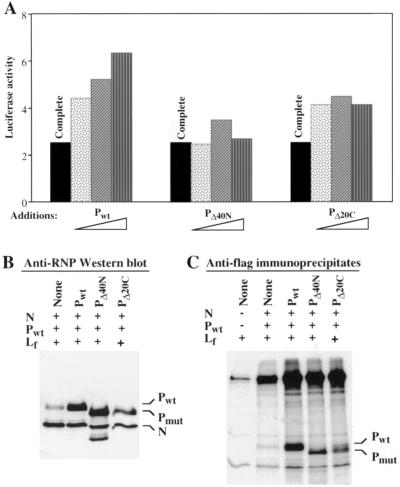FIG. 7.
Stoichiometric requirement for P for efficient minigenome replication, and role of terminal domains in this process. (A) The complete minigenome replication system contained pHPIV3MG(−) (200 ng), pN (640 ng), pLf (200 ng), and pP at a suboptimal concentration (300 ng). pP, pPΔ40N, and pPΔ20C (patterned bars from left to right) were expressed, in addition to the components present in the complete system (solid bar), as indicated above, in increasing concentrations (300, 600, and 900 ng), and luciferase activity in the cell extract was determined. (B) Western blot analysis of N and P proteins using anti-RNP antibody that recognized the N and P proteins. The migration positions of N and P are shown. A protein band migrating faster than N may be a degradation product of PΔ40N. The amounts of plasmid DNAs used are equivalent to the amounts indicated for the complete system. In addition, lanes Pwt, PΔ40N, and PΔ20C contained 900 ng of the respective plasmid DNAs for transfection. (C) Immunoprecipitation of radiolabeled proteins from cells that were transfected with plasmid DNAs as described for panel B, except the first lane contained pLf alone. Cells were metabolically labeled with [35S]methionine and immunoprecipitated by using anti-flag antibody conjugated to Sepharose beads. The precipitated proteins were analyzed in an SDS–10% polyacrylamide gel and subjected to fluorography. The data are representative of three separate experiments with an experimental variability of <10%.

